- See also carne seca, a Mexican dried meat.

Carne-seca ('dried meat' in Portuguese) is a kind of dried, salted meat, usually beef, in Brazilian cuisine.
Carne seca is a frequent accompaniment to black beans. [1]


Carne-seca ('dried meat' in Portuguese) is a kind of dried, salted meat, usually beef, in Brazilian cuisine.
Carne seca is a frequent accompaniment to black beans. [1]


Jerky is lean trimmed meat cut into strips and dehydrated to prevent spoilage. Normally, this drying includes the addition of salt to prevent bacteria growth. The word "jerky" derives from the Quechua word ch'arki which means "dried, salted meat".

Chili con carne, meaning "chili with meat", is a spicy stew containing chili peppers, meat, tomatoes, and often pinto beans or kidney beans. Other seasonings may include garlic, onions, and cumin. The dish originated in northern Mexico.

The cuisine of the Southwestern United States is food styled after the rustic cooking of the Southwestern United States. It comprises a fusion of recipes for things that might have been eaten by Spanish colonial settlers, cowboys, Native Americans, and Mexicans throughout the post-Columbian era; there is, however, a great diversity in this kind of cuisine throughout the Southwestern states.
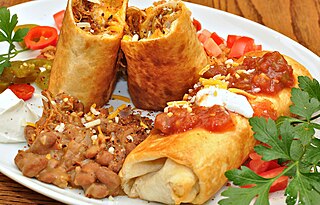
A chimichanga is a deep-fried burrito that is common in Tex-Mex and other Southwestern U.S. cuisine. The dish is typically prepared by filling a flour tortilla with various ingredients, most commonly rice, cheese, beans, and a meat such as machaca, carne adobada, carne seca, or shredded chicken, and folding it into a rectangular package. It is then deep-fried, and can be accompanied by salsa, guacamole, or sour cream.

Carne-de-sol, or jabá is a dish from Northeastern Brazil. It is made by cutting beef into "blankets" which are then lightly salted. The blankets are then placed outside in a dry and ventilated area to cure.
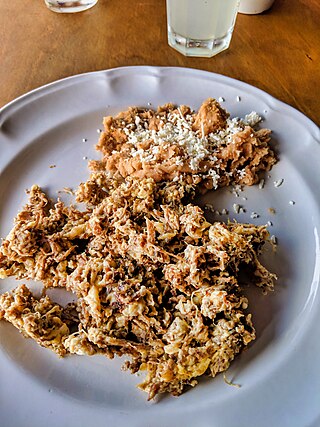
MachacaSpanish:[maˈtʃaka] is a traditionally dried meat, usually spiced beef or pork, that is rehydrated and then used in popular local cuisine in Northern Mexico and the Southwestern United States. It is also readily available in many groceries and supermarkets in these areas. In areas where the dried meat product is not easy to obtain, slow-cooked roast beef (brisket) or skirt steak shredded and then fried is sometimes substituted.

New Mexican cuisine is the cuisine of the Southwestern US state of New Mexico. The region is primarily known for its fusion of Pueblo Native American cuisine with Hispano Spanish and Mexican cuisine originating in Nuevo México. This Southwestern culinary style is popular beyond the current boundaries of New Mexico, and is found throughout the old territories of Nuevo México and the New Mexico Territory, today the state of Arizona, parts of Texas, and the southern portions of Colorado, Utah, and Nevada.
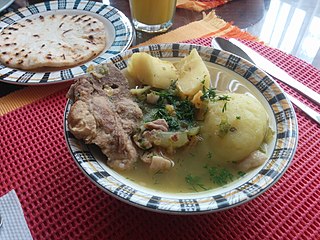
Sancocho is a traditional stew in Canarian cuisine and several Latin American cuisines. Latin variations represent popular national dishes in Dominican Republic, Colombia, Cuba, Honduras, Mexico, Ecuador, Panama, Puerto Rico, Trinidad and Tobago, and Venezuela. It usually consists of large pieces of meat, tubers and vegetables served in a broth.

Dried meat is a feature of many cuisines around the world. Examples include:

Honduran cuisine is a fusion of Mesoamerican, Spanish, Caribbean and African cuisines. There are also dishes from the Garifuna people. Coconut and coconut milk are featured in both sweet and savory dishes. Regional specialties include sopa de caracol, fried fish, tamales, carne asada and baleadas. Other popular dishes include meat roasted with chismol and carne asada, chicken with rice and corn, and fried fish with pickled onions and jalapeños. In the coastal areas and the Bay Islands, seafood and some meats are prepared in many ways, including with coconut milk. Among the soups the Hondurans enjoy are bean soup, mondongo soup, seafood soups and beef soups. Generally all of these soups are mixed with plantains, yuca, and cabbage, and served with corn tortillas.
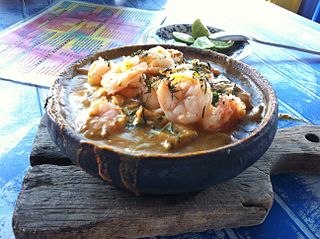
Cazuela is the common name given to a variety of dishes, especially from South America. It receives its name from the cazuela – traditionally, an often shallow pot made of unglazed earthenware used for cooking. The ingredients and preparation vary from region to region, but it is usually a mid-thick flavoured stock obtained from cooking several kinds of meats and vegetables mixed together.

Most traditional foods in Guatemalan cuisine are based on Maya cuisine, with Spanish influence, and prominently feature corn, chilies and beans as key ingredients. Guatemala is famously home to the Hass avocado.
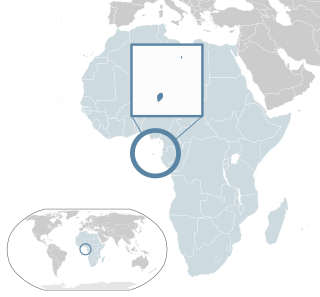
Santomean cuisine comprises the cuisine, dishes and foods of São Tomé and Príncipe, a Portuguese-speaking island nation in the Gulf of Guinea, off the western equatorial coast of Central Africa. The country consists of two archipelagos around the two main islands: São Tomé and Príncipe, located about 140 kilometres (87 mi) apart and about 250 and 225 kilometres, respectively, off the northwestern coast of Gabon.
Carne seca may refer to:

Shredded beef is a preparation of beef that features in dishes from various cuisines. Shredded beef is sometimes prepared using beef brisket and chuck roast. Pot roast is also sometimes shredded.
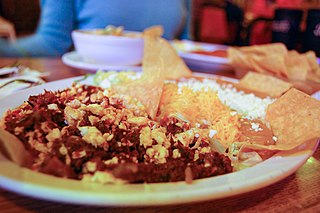
Carne seca is a type of dried beef used in Mexican cuisine.

Arroz carreteiro or carreteiro rice is a dish from the Brazilian state of Rio Grande do Sul which has become popular throughout Brazil. It is made of a rice base to which shredded or cubed beef is added as well as carne-seca or carne-de-sol, paio, bacon or linguiça, a type of sausage. The dish is traditionally flavoured with garlic, onions, tomato and parsley. In the Central-West Region and the Northeast of Brazil, arroz carreteiro is also known as maria-isabel and it is prepared with carne-de-sol.